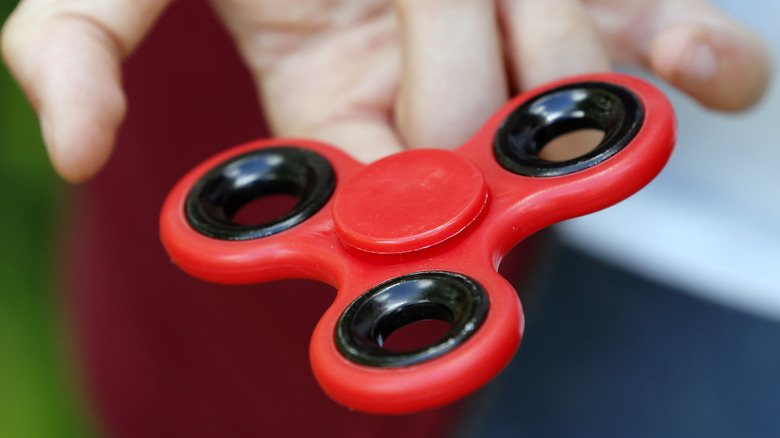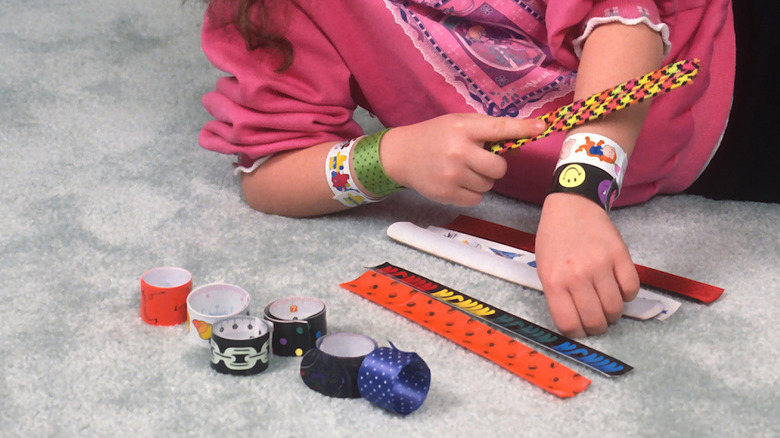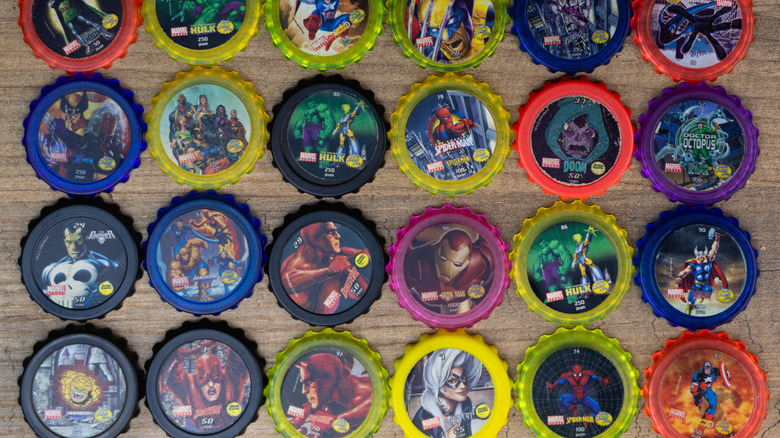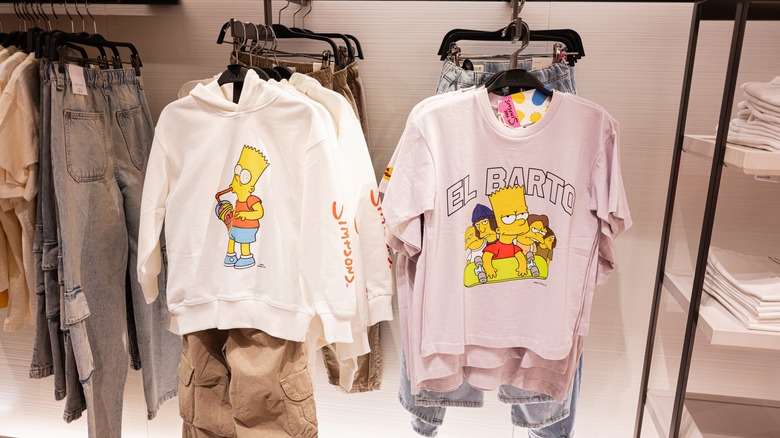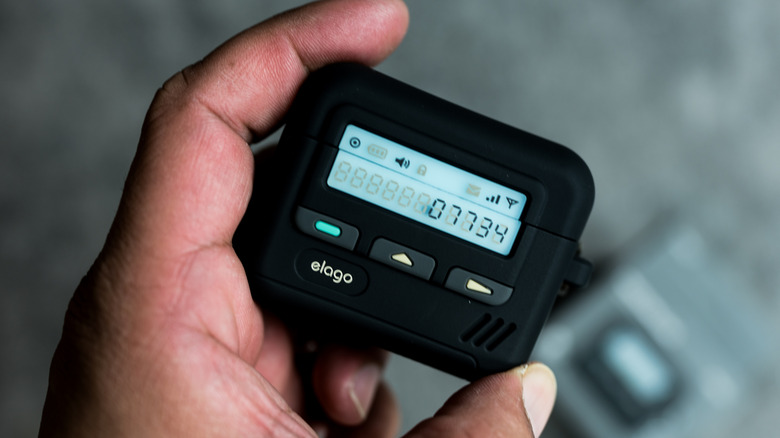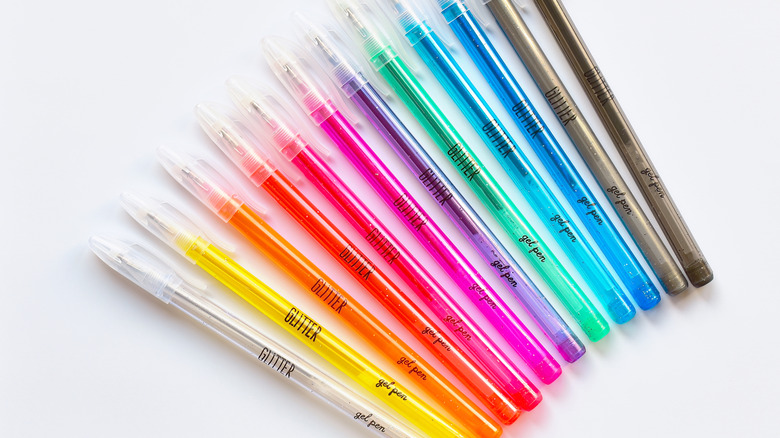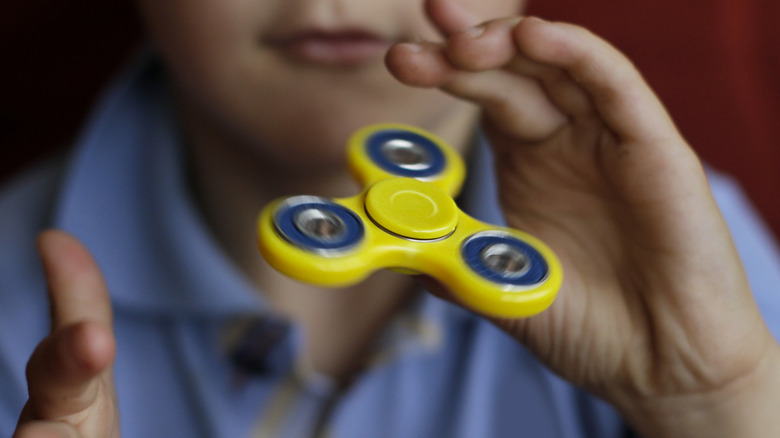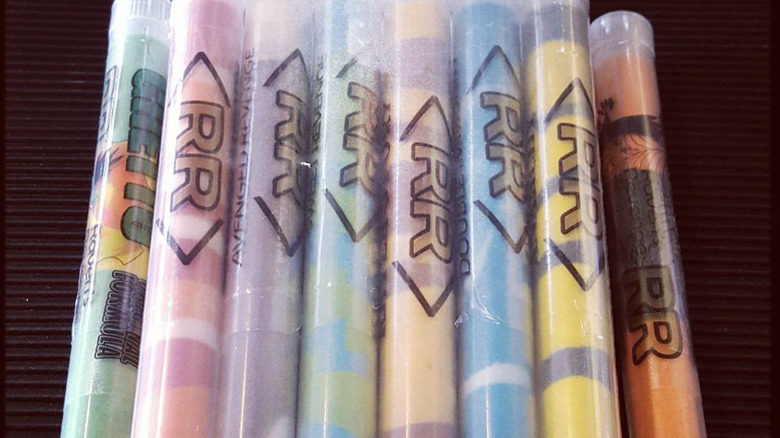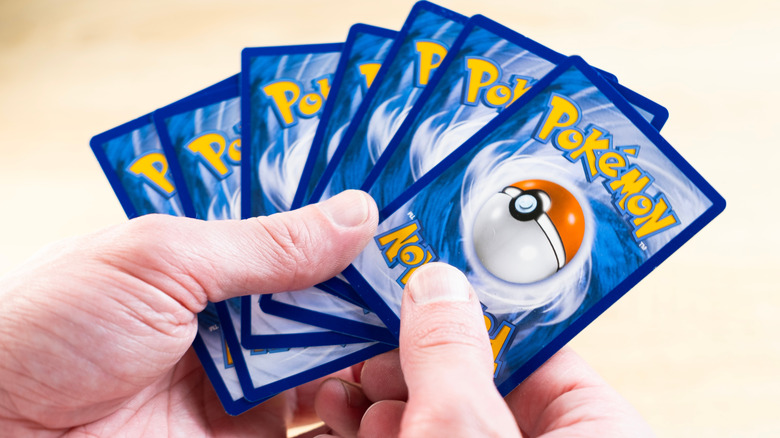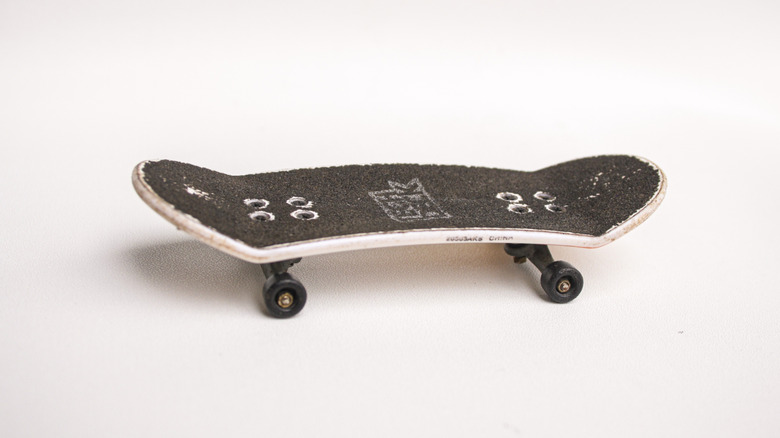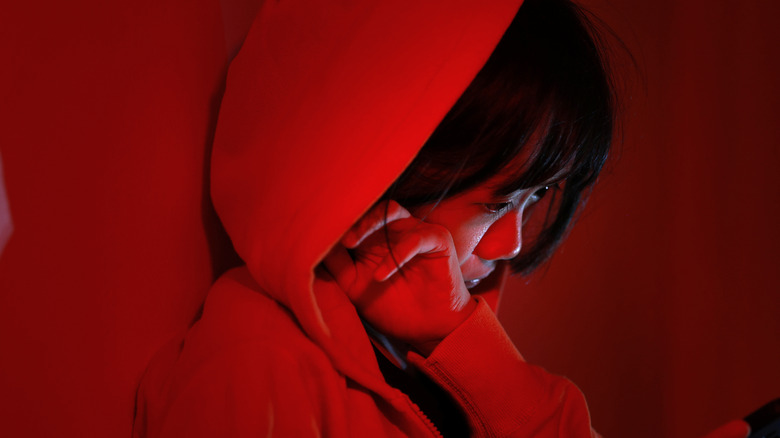Popular Items That Were Banned From US Schools
Elementary schools are supposed to be a place for learning of all kinds. It's where kids in America acquire the collective values and broad history of the nation, as well as the basic skills that will theoretically make them productive members of society. But grade school is also a social scene. It's the stage upon which children act out their identities and participate in the world, getting wind of fads and fashions. Kids talk to each other, and they emulate one another, and it doesn't take too long for a new toy, item of clothing, or personal electronic device to become a big deal once it infiltrates the heavily populated and well-stratified world of schools.
Those faddish things can sometimes get so popular that they threaten the learning environment, which often happened throughout the 1980s, '90s, and 2000s in particular. They're so exciting that they pull focus from classroom lessons or school work, or create a whole litany of new problems. A messed-up thing about elementary school that one only notices as an adult is how easily a trend can get out of control, and how the only effective response from school districts, principals, or teachers is to remove and confiscate the problem materials. Here are some items from the past that were so beloved that they wound up getting banned from schools across the United States.
Slap bracelets
Also called slap wrap bracelets for the way they reshape themselves around the targeted recipient body part, slap bracelets were a major fad in the very early 1990s. Organically violent and thus a bit dangerous, a slap bracelet — as perpetuated by leading brand Slap Wraps — consisted of a thin strip of flexible stainless steel encased in a somewhat softening layer of plastic or another material, decorated in the pattern of the user's choice. They started off as a long, 9-inch strip and then, unlike a pre-shaped piece of jewelry, they naturally wrap around the wrist to form a bracelet that stays in place.
Slap bracelets didn't do much besides make loud contact with skin, which made them a noisy, fidgety attention getter throughout American classrooms in late 1990. They were such a hit that numerous companies popped up to sell cheaply priced and cheaply made Slap Wraps knock-offs, and those were likely to be made with cheap coatings that wore off. That exposed the potentially sharp and caustic metal beneath, landing kids in the nurse's office or urgent care clinic to treat significant cuts. So many children injured themselves — and others — that schools wanted no part of slap bracelets. At least two elementary schools in New York state banned them, followed by institutions in Pennsylvania. Some Walgreens pulled imitation bracelets from its stores, and the Connecticut Department of Consumer Protection issued a recall, after which point the fad ran its course.
Pogs
A distinctively 1990s fad, pogs go back to a card-flipping game created in 17th-century Japan that made its way to Hawaii in the 1920s. Decades later, a teacher there used it in a math lesson and the game caught on, except that in the modern incarnation, players used milk caps or cardboard discs found in locally popular bottles of blends of passionfruit, orange, and guava, or POG for short. In 1994 and 1995, pogs hit the U.S. mainland and more than 350 million individual paper discs — decorated in countless designs — were printed and sold. As collectible as pogs were, the game was simple: Throw an extra-thick pog called a slammer at the tower of the opponent's pogs, and one could claim ownership of whichever ones flipped over.
Pogs became a national obsession for America's kids, and administrators at some schools didn't like the attention it mustered, along with the for-keeps aspect. "I guess you could liken it to going to Las Vegas and losing your money on the table," a California principal named Kathy Muelder — who banned pogs from her elementary school — told the Los Angeles Times in 1994. Many schools throughout the state revoked pogs privileges for their students, too, and so did campuses in Connecticut, Massachusetts, and Pennsylvania, particularly after game disputes led to physical altercations. Bans are a big part of the real reason why pogs disappeared.
Bart Simpson T-shirts
Lots of cartoon characters have changed over time. While "The Simpsons" would evolve into one of the most critically acclaimed, culturally impactful, and longest-running TV series ever made, when it started out in the 1990s it proved controversial for its realistic depiction of dysfunctional families and a supposed glorification of Bart Simpson, an anti-authoritarian, back-talking prankster. Millions of children naturally latched on to what Bart Simpson was selling, and in the first years that "The Simpsons" was a 30-minute TV show, T-shirts featuring his edgy catchphrases were best sellers at stores around the United States.
"Eat my shorts." "I'm Bart Simpson. Who the hell are you?" "Don't have a cow, man." "Underachiever (And proud of it, man)." All of those quips accompanying a picture of Bart appeared on apparel, and they were all deemed so envelope-pushing and confrontational that kids were ordered to stop wearing them to school. Institutions in Michigan, Illinois, and other states went so far as to order students to go home and change into something less incendiary. By 1991, scandalous or not, Bart Simpson shirt sales had cooled off considerably.
Pagers
In the 1980s and 1990s, before the rise of affordable and omnipresent cellular phones, pagers were one of the few ways to remain in semi-permanent contact when away from home. A pocket-sized wireless device with a tiny monochromatic screen, a pager, also called a beeper, carried its own phone number that others could call if they wanted to notify the recipient. Then, they'd call them back from a telephone or meet them.
While plenty of parents issued their children beepers to keep tabs on them, another, smaller American subculture adopted the device: drug dealers. News reports came in from big cities across the country, warning of how pagers were being used to summon drug dealers and facilitate illegal transactions. Making a connection that probably wasn't usually there between the two groups with whom pagers proved most popular, schools far and wide began banning the communications devices. Teachers and administrators saw tweens and teens accepting messages on their pagers and they assumed the worst, that those children were on one side or the other of an illegal drug deal. Because of the tenuous connection to unlawful activity, different jurisdictions imposed serious restrictions on beeper use. New Jersey and the city of Chicago both passed laws making pager possession illegal for anyone under the age of 18, while a city in Michigan threatened jail time to kids caught with a pager at school.
Gel pens
Available in Japan in the 1980s but reaching its peak popularity in the United States around 1999 and 2000, gel pens, or jelly pens as they were also known, came in bright, dazzling, and metallic colors. Kids loved expressing themselves in the otherwise straightforward and sacrosanct realms of schoolwork with new hues, and the opportunity for self-expression expanded into body art. Students of the era found that the water-based, gelled ink pens didn't just glide across paper, they worked on skin, too, and they'd decorate their hands, arms, and faces with whatever words and designs they liked.
By 2001, the item that was technically a school supply but also made potentially dreary classwork a little more fun for kids, was starting to get banned across the United States. After they'd become fully entrenched, teachers noticed that the pens had a tendency to permanently stain classroom carpets and school desks. The jelly ink that stayed on the paper, meanwhile, didn't leave a strong enough impression, leading to countless illegible essays and test papers. "The final product was not very neat. A lot were sloppy," a northern Virginia teacher told The Washington Post regarding a slew of jelly pen-rendered art assignments. All of those technical flaws, along with how the pens had turned into a status symbol and distractingly large collections, led to plenty of teachers telling their students to leave their gel pens at home.
Fidget spinners
The biggest object-oriented, kid-targeted fad of the 2016-2017 school year was supposed to be healthy, organic, and healing. An IT worker named Scott McCoskery found himself bored and performing mindless repetitive tasks during conference calls, prompting the invention of the first fidget spinners. The most popular one used a three-pronged design with a turntable-enabled bearing in the middle. Kids (and adults) could just spin the thing around indefinitely, and it was touted as a way to bolster concentration in individuals with anxiety and attention deficit hyperactivity disorder — the fidget spinner was purportedly a great way to focus and use up nervous energy. McCoskery's patent hadn't been finalized by the time fidget spinners entered mass production, which allowed numerous companies to make them, thus pushing down the price to super-cheap levels and enabling their rise.
Part of the truth about fidget spinners is an ironic twist: The toy that was supposed to help kids focus became a captivating plaything and irritating distraction. "We like to see whose can spin the longest and we kind of have a competition about that," an 11-year-old fidget spinner aficionado told CBS News in May 2017. At that point, schools in about a dozen states had banned fidget spinners from the classroom. As the school year came to an end, and summer came along to help kill the social and classroom sensation, a whopping 32% of high schools had taken measures to prevent the presence of fidget spinners.
Raven's Revenge
Amidst a broader and mouth-puckering sweet-but-painful candy craze of the 1990s, which also included Sour Patch Kids and Warheads, Raven's Revenge quickly and easily earned favor among school-age children. What would eventually endure bans across the country was presented to look like contraband. Raven's Revenge was a sweet and sour candy rendered in powdered form with flavors like sour apple, which was packaged in miniature test tubes stuck with dark, Gothic labels. Because it wasn't widely available in retail establishments, Raven's Revenge was most often found on ice cream trucks or purchased through an intermediary, like a self-proclaimed playground hook-up.
Centered in the Los Angeles area, a former candy store operator from the area named Alexandra "Raven" Montalban invented the treat that bore her name. Its rise to a national phenomenon was cut short when schools started outlawing Raven's Revenge on their grounds. Drugs were to blame, either because the powdered candy resembled drugs, or because some students were using the Raven's Revenge tubes to store and distribute actual illegal drugs.
Pokémon cards
Pokémon is an entertainment juggernaut. More than just an enduring video game franchise that everyone loves despite major flaws and a series of animated TV series, it's also a card game. In the late 1990s and early 2000s, the made-in-Japan game became a cultural phenomenon among American youth, who would buy packs of cards and then square off against one another with the stated strengths, special powers, and weaknesses of their adorable "pocket monsters," like Pikachu, Jigglypuff, Bulbasaur, and Squirtle.
A combination of adorable cartoon characters, magic, fantasy violence, gaming, and a little bit of gambling — kids kept the cards of their vanquished competitors — it's easy to see how Pokémon took off. The devotion that the Pokémon card game in particular inspired made it a major nuisance and distraction to teachers, principals, and playground monitors. Cards went on sale in the U.S. for the first time in January 1999, and by April 1999, after millions of packs had been sold, schools in New York, New Jersey, and Washington had banned the game from their grounds. "The children are beginning to become obsessed by them," Gerald Finelli, a principal in Pelham, New York, told the Associated Press. "We were having instances where kids were losing them and then getting very upset." As the game spread in popularity, so too did the bands, with the game forbidden by schools in Florida, California, and Montana.
Tech decks
As the 1990s came to a close, kids and tweens became fixated on fingerboards, the generic name for miniature skateboards. Roughly four inches long and costing in the neighborhood of $10, the name brand of choice in the field was Tech Decks, which initially comprised more than 200 different models. Made from similar materials as full-size or real skateboards, Tech Decks and other brands became a popular pastime ever so briefly, as children learned all kinds of skateboard moves in miniature, practicing and performing them at home, on the ground at recess, and most catastrophically, on their desks in elementary school classrooms. "It's just another item that's dealt with as a nuisance," Woodland Hills, California, school administrator Larry Meyer told the Los Angeles Daily News (via Deseret News) in 1999. "The teachers take them away and send them to the deans. We require the student to bring a note from home that says, 'I realize they are a disruption and I will keep them at home.'"
Schools in California were joined in their regulation or outright ban of Tech Decks through the duration of the fad in 1999 by schools across the nation. Another subject of annoyance and confiscation at the time were Flick Tricks, which were the mini-bicycle version of the very small skateboards.
Hooded sweatshirts
Hooded sweatshirts, or hoodies as they're known in the common parlance, offer a lot of comforts, such as physical warmth and the ability to fade into the background in plain sight — hood up, drawstrings pulled, and kids hide their faces. That's exactly why the Erie School District in Pennsylvania had a problem with hoodies. In advance of the 2018-2019 school year, the school board and administration decided to ban hoodies from classrooms and campuses. Teachers and principals had complained about having to spend too much of the school day instructing kids to keep their hoods down, which they believed they were keeping up to suspiciously conceal their faces.
Hoodies had already been made forbidden in other regions of the U.S. when in 2015, Schools in Worcester, Massachusetts, also banned them at the behest of the local police force, which claimed that youth-oriented violent crime had been on the rise. Preventing the face-obscuring properties of a hoodie theoretically made young mischief-makers more accountable and identifiable, law enforcement theorized. The Penn Hills School District in Pennsylvania took to suspending students during the 2016-17 school year if they wore hoodies to class.
Tamagotchi
Shaped like an egg and intended to be carried around as a keychain, a Bandai-made Tamagotchi was the first ever virtual pet. On a dot-matrix LCD screen, a digital animal appeared, and users poked at three small buttons to simulate feeding and other necessary maintenance, lest the little thing die. Debuting in Japan in 1996 before becoming one of the biggest Christmas toy crazes in history, Tamagotchi reached the U.S. first in Hawaii in early 1997, and then the contiguous states. By its very design and nature, a Tamagotchi required a lot of attention throughout the day, and thus many of the kids who had them grew fixated on the toy, much to the chagrin and annoyance of their teachers.
Within months of Tamagotchi's appearance in Hawaii, the transfixing and beeping gadget was banned at elementary schools throughout the island of Oahu. Throughout the end of the 1996-1997 year, as the fad expanded rapidly, schools just as quickly ordered kids to leave their Tamagotchi at home or with their parents or risk confiscation. California and New York City schools were especially quick with the bans.
